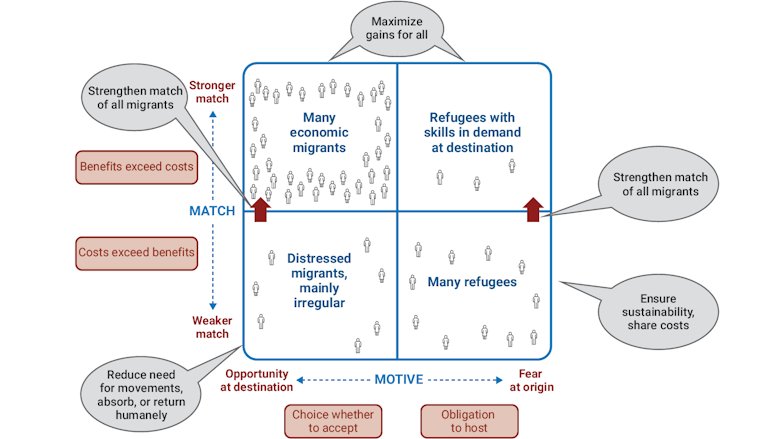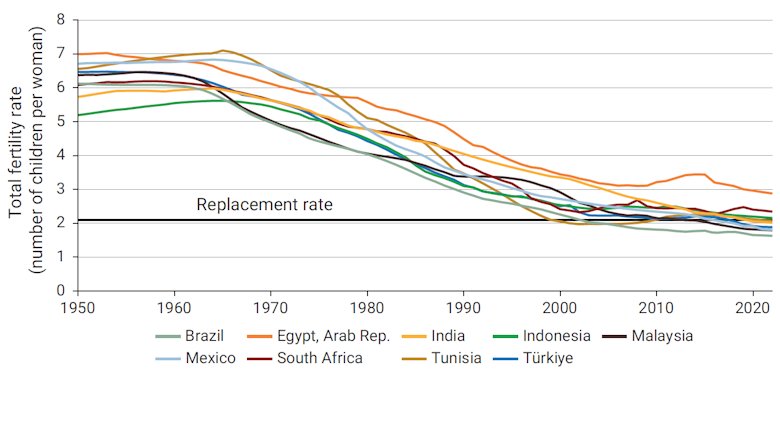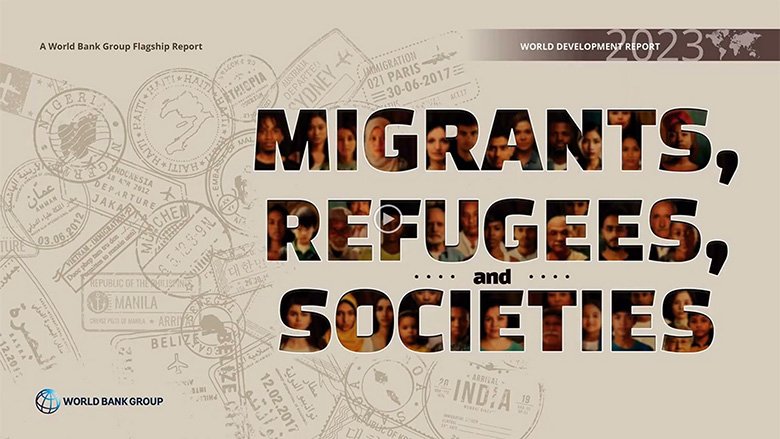Globally, approximately 184 million people, or 2.3% of the world population, live outside their country of citizenship. This highlights the growing complexity of human mobility, which will increasingly be driven by factors like climate change, conflict, divergent demographic trends, and income inequality. These forces are not only pushing more people to relocate for better opportunities but also presenting growing challenges and opportunities for migration policy across various levels of development in the decades to come.
The debate over migration policy is often polarized and contentious. While empirical studies show positive impacts of migration on labor markets, , and in host countries, public opinion often views immigration with apprehension and fear.
While destination countries grapple with the trade-offs of hosting migrants, origin countries face challenges such as brain drain and education system costs. With migration expected to increase, effective policy-making is crucial in both origin and destination countries.
World Development Report 2023 and the Match and Motive Matrix
In a recent Policy Research Talk, World Bank economists Quy-Toan Do and ?a?lar ?zden delved into the subject of migration, highlighting key findings from World Development Report 2023: Migrants, Refugees, and Societies. Both migrants themselves and seasoned researchers in the topic, Do and ?zden co-directed the report (along with Xavier Devictor), which starts with the recognition that cross-border movements inherently involve complex policy trade-offs. At the same time, it distinguishes between the different factors motivating migration in order to better tailor policy responses to distinct types of movement.
To shed light on the decision-making process and policy trade-offs, Do and ?zden presented the primary framework featured in the report―the innovative (Figure 1). The Matrix gives policy makers a powerful tool by integrating many key issues related to migration into a single graph. The Matrix focuses on two factors: the alignment of migrants' skills and attributes with the needs of destination countries, and the motives driving their movements. “Fundamentally, this framework allows us to understand that all migration does not have to be seen as the same phenomenon,” explained Do. “The migrants’ objectives are different, which means the policy trade-offs are different, so the resulting policies need to be different.”
Figure 1: The Match and Motive Matrix
Notes: The Match and Motive Matrix shows that distinct groups of migrants require distinct policy responses. In this framework, each quadrant represents a different set of circumstances. Match refers to the degree to which a migrant's skills and related attributes meet the demands of the destination country. Motive refers to the migrant's reason for moving. Source: World Development Report 2023 (page 21) | See
The Matrix combines two perspectives on migration. The match considers whether the migrant's contribution to the destination country outweighs the costs they impose. A strong match occurs, for example, when the labor market benefits of the migrant exceed the costs of integration, while a weak match arises when the costs outweigh the benefits. Meanwhile, the motive dimension of the matrix takes into account whether the destination country has an obligation to host the migrant under international law obligations. Individuals who relocate due to a well-founded fear of harm or persecution in their home country fall under the definition of refugees and are entitled to international protection.
For migrants with a strong match to begin with, the report recommends that destination countries focus on maximizing gains through policies like providing migrants access to labor markets, recognizing their skills and qualifications, and protecting their rights. When the match is weaker the focus then shifts towards reducing the need for migration in the case of distressed migrants, and towards ensuring sustainability and sharing costs across the international community in the case of refugees. By highlighting the diversity of migration motivations as well as the range of appropriate policy approaches, this matrix serves as a valuable guide for policy makers navigating a complicated set of decisions. The overarching aim is to underscore that migration should ideally be driven by choice rather than desperation or necessity, with benefits for destination countries outweighing the associated costs.
Growing Global Pressures Demand a Renewed Migration Research Agenda
While World Development Report 2023 compiles new research and introduces an innovative framework, it also brings attention to the existing gaps in our knowledge. A large body of research documents traditional factors driving migration like the vast disparities in wages between countries, but significant uncertainties remain. Three global forces in particular will shape migration in the 21st century in ways that are still only partially understood.
The first uncertainty stems from rapid demographic shifts occurring worldwide. “We are at an inflection point because of demography,” said ?zden. “It is the first time in human history that we are witnessing a peaceful population decline in a large number of countries.” High-income countries are aging as people live longer and fertility rates decrease. Simultaneously, middle-income countries like Mexico and India are rapidly transitioning to lower fertility rates, becoming rich before becoming old. Lower-income countries are now leading in terms of fertility; their young populations will be in high demand if they have the human capital demanded in the global labor markets, but will be struggling otherwise. Middle-income countries, whose fertility rates are falling rapidly, may shift from being predominantly origin countries to destination countries (Figure 2). As a result of declining working-age populations in high- and middle-income countries, in the next few decades migration may increasingly be driven by the needs of destination countries, which will have to compete for a shrinking pool of qualified workers.
Figure 2: The Number of Children Born per Woman in Middle-income Countries
Notes: The number of children born per woman in middle-income countries has dramatically decreased over the past 60 years. Source: World Development Report 2023 (page 74)
Second, challenges brought about by climate change are becoming increasingly influential in reshaping patterns of human movement. To date, there is evidence that climate-related cross-border migration has occurred on a small scale. However, a much larger question remains: what will happen when climate change begins to push entire groups of people across national borders? With approximately 40 percent of the global population living in places of high vulnerability to climate change, this remains a pressing issue which demands deeper exploration. Whether and how much climate change will amplify international movements in the coming decades depends on global collaboration to adopt and implement policies for mitigation and adaptation now.
Third, conflict and violence will undoubtedly continue to cause mass movements of refugees, as recent conflicts in Ukraine and the Middle East attest.
Compounding all of these uncertainties is the fact that these drivers of mobility are often closely correlated. The very same countries are often facing the combined challenges of demographic transition, climate vulnerability, poverty, and high fragility (Figure 3). At the same time, ?zden emphasizes that “these compound drivers of mobility are big development challenges, and you cannot address one at a time. The difficult types of mobility we see are symptoms of underlying development challenges.”
The interconnected web of development challenges underscores the complexity of addressing migration issues, emphasizing the need for comprehensive approaches that address root causes. Furthermore, mitigating the compounding drivers of migration requires a united global effort, pointing to the critical role of international cooperation in shaping the future of human mobility.
Figure 3: Four Maps Highlight the Correlation between GDP per Capita, Conflict and Fragility, Vulnerability to Climate Change, and Fertility
Source: World Development Report 2023 (page 80) | See
World Development Report 2023 Is Only the First Step in Understanding Migration in the 21st Century
Given the growing significance of migration policy and the yet unknown impacts of shifting demographics and climate change, it’s evident that a substantial research agenda lies ahead. While World Development Report 2023 has initiated this exploration, there remains a vast landscape to be covered and substantial research to be completed. Over the past 20 years, researchers from the World Bank’s Development Research Group have been actively engaged in studying human migration. For instance, in examining successful models, Columbia stands out for its . Other research notes that deciding to migrate is not a purely economic decision; the “” faced by an individual also present barriers to movement, highlighting the importance of addressing the individual perspective while implementing policies at the state level.
“Migration is necessary, not only for developing countries, but for all countries at all levels of income,” said Do. Investing in a renewed research agenda will help individual migrants, origin and destination countries, and the global community reap the greatest benefits from it.





